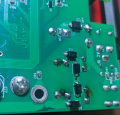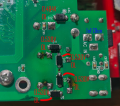MisterBill2
- Joined Jan 23, 2018
- 19,628
We have not been told, other than theyYeah, what is the reason all 5 caps are dead? Overvoltage?
I have soldered the new ones and will try it out soon.
From post #1 " I unsoldered 5 caps at the input, tested them, apparently all broken (good news), ". My guess is that they may have been damaged by over voltage, although there is a statement that "it works, BUT"Yeah, what is the reason all 5 caps are dead? Overvoltage?
I have soldered the new ones and will try it out soon.









